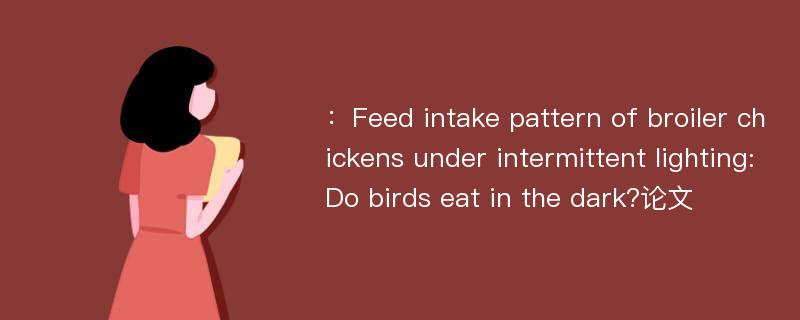
本文主要研究内容
作者(2019)在《Feed intake pattern of broiler chickens under intermittent lighting:Do birds eat in the dark?》一文中研究指出:This paper reflects the results of a short experiment conducted in parallel with a larger trial which aimed to test the assumption that ’consumption of feed by broiler chickens during periods of darkness is largely negligible’. To that effect, on d 31, feeders of birds raised under intermittent lighting(IL), i.e. 1 h of light[1L]:3 h of dark(3D):1L:3D:1L:3D:1L:3D:2L:6D, were weighed at the onset and at the end of each period of darkness(or scotoperiod). Moreover, in order to compare the feeding behavior of IL birds with that of broilers raised under continuous lighting(CL, i.e, 18L:6D), their feeders were weighed in parallel and at the same time points. On d 31, feed intake of IL birds during scotoperiods represented 45% of their 24 h feed intake. Both CL and IL birds presented anticipatory feed intake prior to the long nocturnal period of darkness(6D), as well as higher feed intake right at the onset of lighting at 06:00. Feed intake of CL birds during the 6D nocturnal scotoperiod was negligible at around 2% of their total feed intake. Intermittent lighting birds exhibited excitement at the start of each hour-length scotoperiod and, within that time,ingested around 2.5 times the amount of feed ingested by CL birds. Although short, this study revealed several interesting observations which might be worth further exploring in a larger, lengthier, behaviorfocused experiment. Amongst other factors, it might be interesting to understand whether the high feed intake observed during scotoperiods for IL birds in reflective of the whole flock or rather a coping mechanism developed mainly by hierarchically lower-ranking birds to achieve their daily feed intakes requirements.
Abstract
This paper reflects the results of a short experiment conducted in parallel with a larger trial which aimed to test the assumption that ’consumption of feed by broiler chickens during periods of darkness is largely negligible’. To that effect, on d 31, feeders of birds raised under intermittent lighting(IL), i.e. 1 h of light[1L]:3 h of dark(3D):1L:3D:1L:3D:1L:3D:2L:6D, were weighed at the onset and at the end of each period of darkness(or scotoperiod). Moreover, in order to compare the feeding behavior of IL birds with that of broilers raised under continuous lighting(CL, i.e, 18L:6D), their feeders were weighed in parallel and at the same time points. On d 31, feed intake of IL birds during scotoperiods represented 45% of their 24 h feed intake. Both CL and IL birds presented anticipatory feed intake prior to the long nocturnal period of darkness(6D), as well as higher feed intake right at the onset of lighting at 06:00. Feed intake of CL birds during the 6D nocturnal scotoperiod was negligible at around 2% of their total feed intake. Intermittent lighting birds exhibited excitement at the start of each hour-length scotoperiod and, within that time,ingested around 2.5 times the amount of feed ingested by CL birds. Although short, this study revealed several interesting observations which might be worth further exploring in a larger, lengthier, behaviorfocused experiment. Amongst other factors, it might be interesting to understand whether the high feed intake observed during scotoperiods for IL birds in reflective of the whole flock or rather a coping mechanism developed mainly by hierarchically lower-ranking birds to achieve their daily feed intakes requirements.
论文参考文献
论文详细介绍
论文作者分别是来自Animal Nutrition的,发表于刊物Animal Nutrition2019年02期论文,是一篇关于,Animal Nutrition2019年02期论文的文章。本文可供学术参考使用,各位学者可以免费参考阅读下载,文章观点不代表本站观点,资料来自Animal Nutrition2019年02期论文网站,若本站收录的文献无意侵犯了您的著作版权,请联系我们删除。
